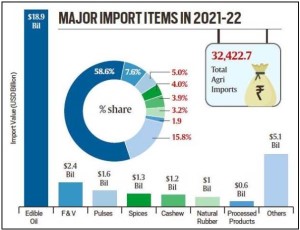Supply disruptions during the pandemic and the Russia-Ukraine war have led many nations to think about “self-sufficiency” in critical food items or at least reduce their “excessive dependence” on imports of essential food products.
India’s import dependence for edible oil
- India imports 55 to 60 per cent of its edible oil requirements.
- India’s edible oil import bill in 2021-22 (FY22) crossed $19 billion
- Palm oil comprises more than 50 per cent of India’s edible oil imports, followed by soybean and sunflower.
- The “excessive dependence” on imports has raised the pitch for “atmanirbharta” in edible oil.
- The Prime Minister launched the National Edible Oil Mission-Oil Palm (NEOM-OP) in 2021.
Way forward
- Develop oil palm: Given the way international prices of edible oils have surged in the last year or so (by more than 70 per cent), it may be time for India to ramp up its efforts in developing oil palm.
- Declare oil palm as a plantation crop and allow the corporate players to own/lease land on a long-term basis to develop their own plantations and processing units.
Why oil palm?
- Achieving atmanirbharta in edible oils through traditional oilseeds such as mustard, groundnuts and soya would require an additional area of about 39 million hectares under oilseeds.
- Danger to food security: Such a large tract of land will not be available without cutting down the area under key staples (cereals) – this could endanger the country’s food security even more.
Challenges:
- Long gestation period: It takes four to six years to come to maturity; during this period, smallholders need to be fully supported.
- Further, the pricing formula of fresh fruit bunches (FFB) for farmers has to be dovetailed with a likely long-run average landed price of crude palm oil with due flexibility in the import duty structure.
Way forward:
- One needs to identify trigger points when import duties need to be raised as global prices come down, and when to reduce these duties in case of rising global prices.
- Overall, unless India thinks holistically and adopts a long-term vision, the chances of reducing India’s imports of edible oils from 14MMT in FY22 to 7MMT by FY27 look bleak.
READ MORE: Daily Prelims Booster
READ MORE: Daily News Analysis

Leave a Comment